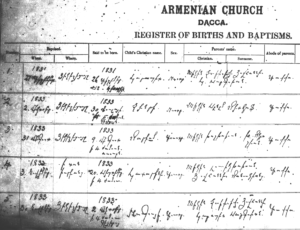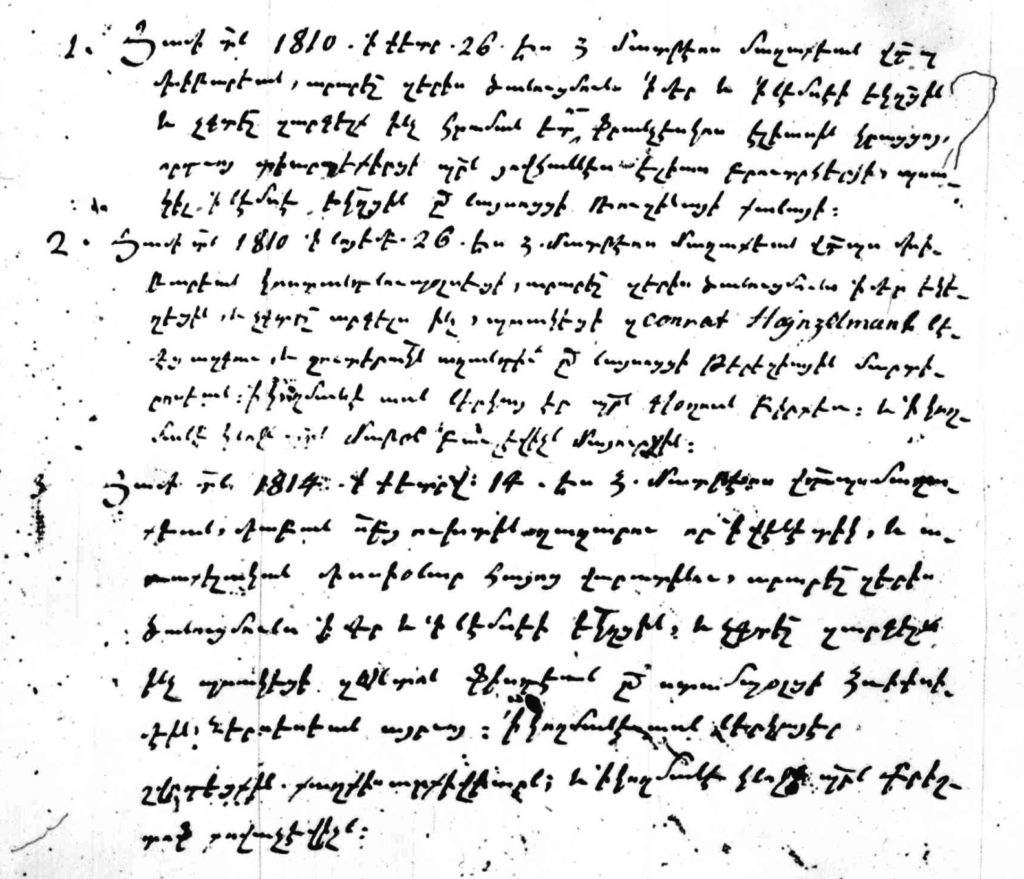This article is part of a continuing series documenting the available records for research into one’s Armenian family roots. Part I in the series supplied a historical background on the Armenian genealogy movement as well as specific records available for Syria. In Part 2, records from Lebanon and Israel were detailed. Part 3 covered the records of Greece and Jordan.
Southeast Asia – Bangladesh, Burma, India, Indonesia, Singapore
The Armenian communities of Southeast Asia trace their origins to international trade routes. Merchant families have played an important role in these communities for centuries. Many unique aspects of this community make the paths to researching it quite varied.
For one, the Armenian communities of Southeast Asia were intimately tied to the British Empire and its world-wide business interests. As such, British colonial records offer an important source for information. Luckily, Liz Chater runs a useful blog devoted to the Armenians of India and beyond. I cannot say enough about the wonderful work she has done.
Chater suggests starting with the website for Families in British India Society (FIBIS). You can search their database for free and access additional services for a fee. You can find a number of Armenian related names. The British Library contains some of the Armenian baptism, marriage and burial records from India. Digitized images of the records can be accessed findmypast. A fee will be charged after a 14-day free trial.
There are other general resources available via websites and Chater has documented these as well as useful suggestions on her website. One can also contact the individual churches at the following addresses compiled by Chater.
Also, as stated in previous articles in this series, the Latter Day Saints (LDS) Family History Library contains a wealth of information related to Armenian church records. FamilySearch.org is in the midst of a long-term project to digitize their collection of records. The result will eventually be that instead of ordering microfilm, researchers will be able to view the records on-line at a local Family History Center or at the LDS Family History Library in Salt Lake City. Some records are also available without restriction now through FamilySearch.org.
The following details the time periods for which individual church records are available through the LDS Family History Library:
- St. Haroutiun (Bangladesh) – 1831- 1981
- St. Hovhannes Garabed (Burma) – 1857-1981
- St. Bedros (Bombay, India) – 1917-1978
- Holy Church of Nazareth (Calcutta, India) – 1793-1982
- Armenian Apostolic Church (Madras, India) – 1829-1908
- Armenian Apostolic Church (Tangra, India) – 1793-1979
- St. Hovhannes (Jakarta, Indonesia) – 1836-1964
- St. Kevork (Surabaya, Indonesia) – 1927-1976
- St. Krikor Lusavorich (Singapore) – 1827-1976
Unfortunately, the images of many of these early records are very difficult to read. In addition, the naming conventions can seem odd to those unfamiliar with this type of work. Nonetheless, they are an excellent primary source.

Previously, I have not mentioned the role memorial books (“houshamadyan”) for different locales can play in genealogy. Houshamadyan.org has a wonderful bibliography of the memorial books compiled by Mihran Minassian.

Many of these books contain detailed information and biographies of natives of the specific village, town or district. They supply a wealth of information, not only on specific people, but also on general Armenian village life. In the case of India, there are some wonderfully detailed sources, specifically Mesrovb Jacob Seth’s massive tome “Armenians in India.”
| Saint Mary’s Armenian Church, Chennai 60 Armenian Street Chennai India |
Saint John the Baptist Armenian Church, Chinsurah 4/4 Armanitola Chinsurah Hooghly West Bengal India |
| Holy Resurrection Armenian Church Dhaka 4 Armenian Street Armanitola Dhaka Bangladesh |
The Armenian Chapel, Delhi Armenian Cemetery Rama Park Kishan Gunj Delhi,6 |
| Armenian Holy Church of Nazareth, Kolkata 2 Armenian Street Kolkata 700001 West Bengal India |
Saint Gregory the Illuminator Armenian Church, Kolkata 41B North Range, Kolkata 700071 West Bengal India |
| Saint Peter’s Armenian Church, Mumbai Ararat Building 89 Nagindas Master Road Fort Mumbai 400023 India |
Saint Mary’s Armenian Church, Saidabad Girbijapara, P.O. Khagra Saidabad Murshidabad West Bengal India |
| Armenian Church of St. Gregory the Illuminator Singapore 60 Hill Street Singapore 179366 |
Holy Trinity Armenian Church, Tangra 2 South Tangra Road Kolkata 700046 West Bengal India |
| Yangon Armenian Church 66 Bo Aung Kyaw Street Yangon 11182 Myanmar |
Serbia
The Armenian communities in what is now the Republic of Serbia date to at least the 17th century. A surviving parish register covering Belgrade and Petrovaradin was located in the Armenian Catholic Mekhitarist Monastery of Vienna, Austria (manuscript #1338). The register of sacraments begins in 1732 and continues to 1931 in some cases. Given the importance of the Mekhitarist order and its extensive libraries in both Vienna and Venice, it is hoped more gems like this are found and made available. Microfilmed in 1981, the LDS Family History Library also contains the records of the former Yugoslavia.
One of the other interesting sources from the archives of the Mekhitarist order is a student roster from the Mourad-Raphael College of Venice. It begins with students who graduated in 1841 and continues into the 1890’s. While the form includes space for the names of the mother and father of the student, it is rarely filled in. However, the birthplace and years enrolled in the college are typically shown. The great majority of students were from Constantinople [Istanbul], but also occasionally from the Black Sea region and even less frequently elsewhere.

Author information
The post Research Your Armenian Roots—What You Need to Know (Part IV) appeared first on The Armenian Weekly.
Source: Armenian Weekly
Link: Research Your Armenian Roots—What You Need to Know (Part IV)
